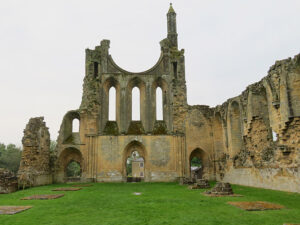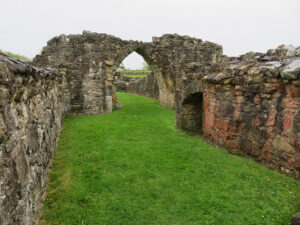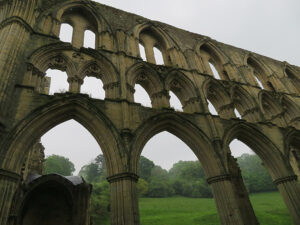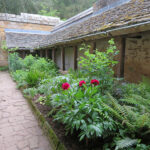Close to 5:00am the next morning, we both woke with the early light of the northern county. We were able to go back to sleep, but I still woke at 7:00, my usual time, and wrote. Finally, at 8:30 Vere got up and we went downstairs to the breakfast dining room for our requested breakfast at 9:00. A radio was playing sofetly and we were the only ones there. We sat at one of the four tables and watched the sun get brighter in the ample back yard, set up with tables, chairs, a barbecue, and spring flower beds.
I also walked around the room looking at the art on the walls. They had many floral watercolor paintings by Greta Janaviciene. Then Andy came in with tea and came right back with our food. I had two soft boiled eggs in their shells with “brown soldiers” (wheat toast, cut in long strips) with fruit and yogurt, and Vere had Eggs Benedict. Each was perfect, then we left for the day.
Our first stop was at Byland Abbey, just down the road, nestled in the Ryedale district of North Yorkshire in North York Moors National Park.
The abbey was founded as a Savigniac Abbey in January 1135 and was later absorbed by the Cistercian order in 1147. It was not an easy start for the community, which had to move five times before settling at New Byland, near Coxwold, in 1177. There were early disputes with other abbeys over trade, but it was famed for its sheep rearing and wool exports. In the late 12th century, the abbey housed thirty-six monks and one hundred lay brothers. Its church was said to be among the finest 12th century churches in Europe, known as “one of the three shining lights of the north,” Fountains Abbey and Rievaulx Abbey being the other two.
In October 1322, King Edward II was at Byland Abbey when a group of marauding Scots caught Edward unaware. He fled to York while the Battle of Old Byland took place. By the time of the Dissolution of the Monasteries in November 1538, the abbey was down to twenty-five monks and an abbot. In 1539, the abbey was granted to Sir William Pickering, whose family passed it down, until it was finally given to the English Heritage Trust. The abbey is known to have ghosts.
We parked in the small lot across from the abbey, slipped on waterproof booties over our walking shoes to wade through the wet grass, put on our jackets for the morning chill, and grabbed our brollies for the drizzle. The abbey still has impressive remains. On its west side, the front of the church is quite tall at sixteen feet, while most of the walls are in ruins. There is a surviving limestone gatehouse, which has capitals supporting a round arch. Also a large rose window, which was repaired in 2016, and served as an inspiration for the one at York Minster. There were many places on the ground that were covered with dark heavy plastic sheeting, which covered medieval floor tiles to protect them. An altar table was recovered, but is now in Ampleforth Abbey, and a stone lectern from the chapter house is the only example of its kind in Britain. We enjoyed walking the entire area over grassy mounds and around low stone walls covered in lichen and moss, and reading the sign boards that described what each area was.
Then we were on to Rievaulx Abbey. On the way, we saw a long-legged and tall-eared jack rabbit clip-hop across the road. We also saw several wild pheasants in the fields, with their characteristic blue heads, red faces, white neck rings, rust reddish-brown feathered bodies, and long tails. At one point we heard several rifle shots. Official hunting season was closed that time of year for anything but fox.
Rievaulx Abbey was the first Cistercian monastery in the north of England, founded in 1132.
Its remote location was well-suited to the order’s ideal strict life of prayer, seclusion, and self-sufficiency. The first abbot was William I, who brought in twelve monks from Clairvaux Abbey. Abbot Aelred was the second, who expanded the abbey and grew its members to 140 monks and 500 lay brothers.
Sheltered by hills, the abbey lies next to the River Rye in a wooded dale. The monks diverted part of the river to have enough flat land to build on. The ingenuity of the monks continued, building up a profitable business mining lead and iron ore, rearing sheep, and selling wool to buyers from all over Europe.
But at the end of the 13th century, the abbey incurred multiple problems: building debts, lost revenue from an epidemic of sheep mange, raiders from Scotland, and then there was the Black Death. So it was forced to lease its land. By 1381, there remained only fourteen monks, three lay brothers, and the abbot. But they held on. By the 15th century the strict Cistercian practices were abandoned. The monks were permitted to eat meat and enjoyed private living accommodations, and the abbot took over the infirmary, making it his private residence. This troubled the authorities, who sent someone, but they refused to follow him, and he was forced out.
At the time of its dissolution in 1538, the abbey was said to have an income of £351 a year, consisting of seventy-two buildings occupied by the abbot and twenty-one monks, with 102 lay employees. The abbey owned a prototype blast furnace that produced cast iron as efficiently as a modern one, which brought in a good amount of revenue. But, as was standard procedure during the dissolution, the monastic buildings and furnace were confiscated, the abbey was made uninhabitable, and it was stripped of its valuables. The site was then granted to Thomas Manners, 1st Earl of Rutland, one of Henry VIII advisers, until it passed to the Duncombe family. In the 1750s, Thomas Duncombe III laid a terraced walkway along the top of the ridge with two Grecian-styled temples, in order to get a picturesque view looking down upon the abbey ruins. Rievaulx Abbey is now managed by English Heritage.
Walking around this grand abbey in the mist and light rain, and it being so quiet amidst the ruins, produced a downtrodden feeling of how the monks must have felt, having had their abbey home destroyed. The Gothic doorways were tall, a small wall indentation showed where candlelight once rested, and one far corner of the lawn showed where an immense cloister once stood. Two signs caught our attention. Once said “Beware, this view will live long in your memory,” and another said, “Warning, smelling these flowers will transport you back in time.”
Afterward, we ate lunch in the small café attached to the gift shop and watched the light shift over the abbey through large glass windows. We could easily understand how this abbey had once been one of the three great abbeys of the north.
Our next stop of the day was to visit Mount Grace Priory, including rooms to see in the manor house in front of the abbey.
Mount Grace is another one of those “shining lights of the north.” In 1398, Thomas Holland, 1st Duke of Surrey, founded the late medieval Carthusian monastery. He did so because he had two relatives who supported the Carthusians. In the beginning it was fairly small, with room for only one prior and twenty-three monks, but it did have a church and unusually, two cloisters; a larger one to the north of the church that had cells for seventeen monks, and a smaller one to the south that had six cells for lay brothers.
In 1399, Holland’s uncle, King Richard II, was deposed, and the following year Holland was executed, after it was found that he supported a coup against Henry IV. Since Mount Grace was then left without a leader and had no income to support it, it had to depend upon the generosity of the royals for a time. In 1410 the house was formally incorporated into the Carthusian Order, and Nicholas Love was named fourth rector and first prior. It also received a number of grants and charters to keep operating. The monks lived like hermits, were strict vegetarians, valued hygiene, and each lived in their own small house. During hours of prayer during the day, each sang in their home, and only came together to pray in the evenings, on Sundays, and on feast days. Other than that, they were silent.
In 1534, when some of the monks refused to take the oath of supremacy to the crown, they were imprisoned. Then in 1539, with Henry VIII’s Dissolution of the Monasteries, the priory was closed. After that, Mount Grace passed into private ownership, and the remaining brothers were given pensions.
We walked around the house. Downstairs had a living room where the last occupant had lived, and there was a gift shop. Upstairs there was a walk-through museum and history display about the abbey. Then we went out the back door and circled the abbey grounds. The entire area of gray stones was softened by large areas of cut dark green grass. The air laden with mist and the cloud layer low leant an old-world feel to the place. We walked among the ruined stone walls, some still towering above us, a monk of stone looking up to heaven, and in some places in the grass only the stone bases were left to indicate where pillars once stood. We walked where a huge cloister had once been, and in areas where the monks once lived. Each monk had a private place to write, pray, sleep, and had a garden of their own. One monk’s dwelling had been reconstructed so visitors could see how they lived. There was even an angled shelf where monks would receive their food but could not be seen. Behind the line of monks homes was a spring that ran through the property.
Then we walked the descending gardens in front of the priory, following a stream that came from the hillside behind the monk’s cells and reappeared in the front gardens. The water formed rivulets and ponds and ran past beautifully-dressed flower beds. Some flowers were in bloom, but many were still on the verge, waiting for a sunny day. We sat at the bottom of the gardens on a bench next to a gazebo. From there we could survey the ponds and gardens, and look up at the house. It was truly a lovely place to contemplate its troubled history and admire how it had all been transformed into a great place to visit.
Then we headed back to our B&B. On the way back we saw a dead deer, hooves up, on the side of the road. Someone must have hit it and moved it to the edge. We rested for an hour or so and then found a place just up the road for dinner.
The quaint Stapylton Arms is in the picturesque village of Wass. It has a tiny pub and three small rooms for dining. The building was constructed in 1620, originally as a granary, and then became an ale house in 1645. In 1739, the Inn became known as The Stapylton Arms following the purchase of the entire village by the Stapylton family of Myton on Swale. The pub retained this name until 1896, when the village was purchased by Sir George Wombwell of nearby Newburgh Priory, and the pub briefly was called the Wombwell Inn. When the village and pub were sold off from the Wombwell estate in 1924, the pub reverted to the Stapylton Arms, and was bought by new owners in 2016.
For dinner, we both had starters. Vere had the chicken liver and brandy pate with chutney and toast, and I had the twice-baked mature cheddar cheese soufflé. Then he had the pan-fried medallions of pork fillet with bacon and cream sauce, and I had the baked salmon supreme with lobster cream sauce. Both came with potatoes Dauphinoise. We shared one serving of warm sticky toffee pudding with toffee sauce. Everything was excellent. Then it was back to the B&B to relax before bed.






























 The official website of Lita-Luise Chappell, writer on sex, magic, food, distant lands, and everyday life with articles, poetry, novels, travelogues, rituals, cookbooks, and short-stories.
The official website of Lita-Luise Chappell, writer on sex, magic, food, distant lands, and everyday life with articles, poetry, novels, travelogues, rituals, cookbooks, and short-stories.
